After 10 years, it’s happening.
Annual memberships in Portland’s city-owned, Nike-sponsored public bike sharing system went on sale at 6:20 a.m. Tuesday, and the 1,000-bike system to be known as Biketown will get one of North America’s largest-ever bike share launches on Tuesday, July 19.
Memberships will cost $12 a month with a one-year contract that comes with 90 free minutes per day. If you don’t want to make an annual commitment, you can opt to buy a single ride of up to 30 minutes for $2.50, or a 24-hour pass with 180 free minutes for $12.
In all cases, you’ll pay 10 cents per minute for any additional time over your free allotment.
Unlike with most other U.S. bike sharing systems, there won’t be a month-to-month option for most users.
System will be unusual in several ways

(Photo: City of Orlando)
As we’ve discussed in our previous reporting, Portland’s “smart bike” system will be one of the country’s first.
If you want to drop a Biketown bike anywhere on the same block face as one of the official racks, that’ll count as being “docked” because the bike will be able to detect that it’s close to home base. This eliminates one of the major frustrations of most bike share systems: arriving at a station to find it full.
If you want, you’ll also be able to drop one of the smart bikes away from a station, anywhere in the service area, for a $2 penalty fee. If you pick up a bike that’s away from a rack and finish your trip inside a “station” area, you’ll get a $1 credit to your account.
Biketown will be the largest such system in the United States so far, though smaller smart bike systems are operating in Phoenix, Tampa, Boise, Orlando and elsewhere.
The first 500 people to register for annual memberships can get the first month free with the code “PDX500.”
Some employers and apartment buildings may choose to offer discounted memberships for their employees. Those will go on sale later in the summer.
Final station locations invest heavily in west side
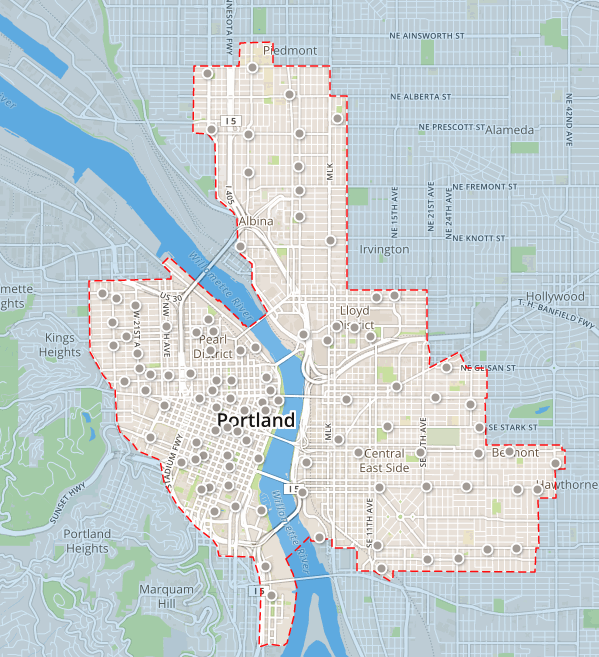
The first 100 stations in the Biketown system — city officials hope to gradually add more over the coming years — will be concentrated mostly in downtown and inner northwest Portland, which the city says have the best combination of residential density, commercial density, job density, transit service and low-income residents.
“Every station has multiple points of demand that we can pull off of,” city bike-share manager Steve Hoyt-McBeth said in a press briefing Monday.
On the west side, if you’re between NW Vaughn, NW 25th, SW Vista and the lower part of the Interstate 405 loop, you’ll rarely be more than three blocks from a station.
Advertisement
“We really took lessons from cities across the country that bike share works best not only when you put stations in high-demand areas, but when you put a high level of service in those areas,” Hoyt-McBeth said.
Six stations will sit immediately off the Transit Mall; four will sit immediately off the Park Blocks.
In addition, a decent swath of the inner east side will get a station every seven to 10 blocks, with a focus on transit nodes and commercial districts. The easternmost station will be just east of SE Cesar Chavez Boulevard at Taylor Street; the northernmost will be just south of N Killingsworth at Albina. Southeast Woodward will form most of the southeast boundary.
“There’s more stations that we want to put down,” Hoyt-McBeth said. “We would love to fill in, and I think over time we can expand.”
Scattered among the city’s 100 stations will be 20 “kiosks,” enhanced stations that let you buy a membership with a credit card. (You’ll also be able to do so anywhere using a mobile phone or the Internet.)
City ponders “blowback” possibilities; stations appear in three weeks
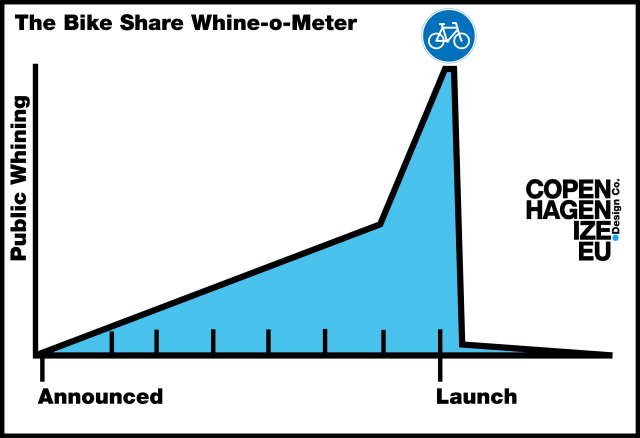
The Biketown equipment has already begun arriving in city warehouses and the racks will appear on streets in the “beginning of July,” said Biketown general manager Dorothy Mitchell, a former city employee now running the system on behalf of operator Motivate.
“We were preparing ourselves based on what we’ve seen in other cities for a lot of blowback,” Hoyt-McBeth said. “It’s something new. People don’t know what it is.”
Whether or not that happens, Hoyt-McBeth argues it won’t be for lack of trying. He said the city based its station locations in part on 4,500 comments submitted online, at five open houses around the city this spring and at 40 stakeholder or community meetings over recent months.
Some stations will sit in street space currently used for auto parking. Hoyt-McBeth said the city’s parking operations team continues to scour every station area to find ways to create new parking spaces and reduce or even eliminate net parking loss.
“We’ve been able to find these obsolete no-parking zones, either from when a one-way street was two-way or there was a loading zone that somebody needed for a tenant that’s long gone,” he said. “We’re actually adding spaces back in as the system rolls out.”
Outreach to low-income Portlanders planned
(Photo: J.Maus/BikePortland)
Unlike private bicycle transportation, most modern bike sharing systems in the United States have struggled to attract users who are anything other than educated, white and relatively well-to-do. In Washington DC, for example, 25 percent of people who work in the city are African-American, but only 3 percent of Capital Bikeshare members are.
No one’s quite sure why this is true; there are probably multiple reasons.
Portland recently scored a grant to try to do better with Biketown.
The $75,000 grant from the Better Bike Share Partnership will fund a partnership with the Community Cycling Center, which will replicate its longstanding Earn a Bike Program for bike sharing by offering free classes to low-income Portlanders. If they finish, they’ll earn what Hoyt-McBeth said will be “near free” bike-share memberships.
“The CCC will be going to affordable housing units, knocking on doors, telling people about bike share,” he said. Or “a social worker will call and say, hey, so-and-so needs a bike. We’re going to kind of leverage those relationships that the CCC has.”
The city hopes it’ll help that it’s deliberately located many stations very close to publicly supported housing units.
Of the 13,000 such housing units in service area — which is 55 percent of the 23,600 citywide, the Mercury reported — Hoyt-McBeth said, 96 percent are within quarter-mile of a Biketown station and 64 percent are within 500 feet of a biketown station.
(Disclosure: my other job as a staff writer for PeopleForBikes includes editing the Better Bike Share Partnership’s website. I’m not involved in the grant process.)
System will offer goodies for ‘Founding members’
In addition to the free first month for the first 500 people to commit to the $12-a-month membership, the first 1,000 to sign up will be designated as “founding members” and receive a specially branded t-shirt and bike share access card that they’ll get to use permanently.
Because Portland’s pricing system is unique — a relatively high annualized rate with no month-to-month option, but billed using monthly payments that are smaller than the monthly rate almost anywhere in North America — Biketown will break new ground in bike share pricing. Mitchell, the general manager, said with an only slightly uneasy smile that she’ll be interested to see how fast the memberships sell.
Whatever happens, there’s no question that this’ll be a historic summer for bicycle transportation in Portland.
“This is a new public transit system,” Hoyt-McBeth said. “We have streetcar and aerial tram, and this is our third.”
Correction 8:40 am: An earlier version of this post gave the wrong number of kiosks, and misquoted a past-tense phrase (“we were expecting a lot of blowback”) as a present-tense one (“we’re expecting a lot of blowback”).
— Michael Andersen, (503) 333-7824 – michael@bikeportland.org
Our work is supported by subscribers. Please become one today.


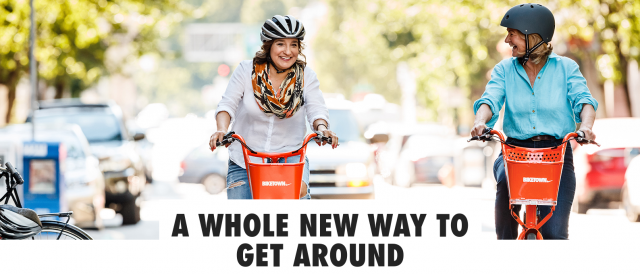
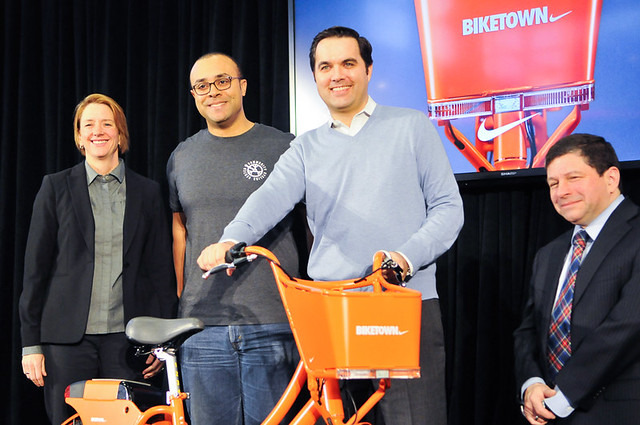
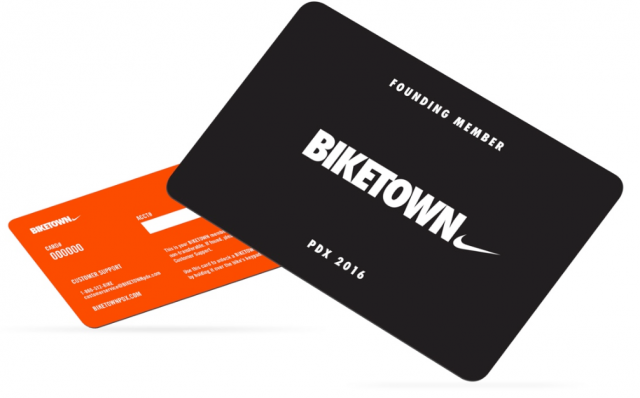




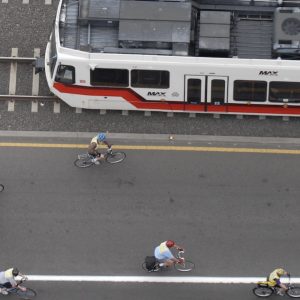
Thanks for reading.
BikePortland has served this community with independent community journalism since 2005. We rely on subscriptions from readers like you to survive. Your financial support is vital in keeping this valuable resource alive and well.
Please subscribe today to strengthen and expand our work.
Don’t forget to enter promo code PDX500 in the promo code drop down box when you sign up to get your first month free on your annual membership, thanks to Metro.
Cool, just signed up. I’m willing to ignore the Nike swoosh I normally avoid in exchange for their excellent sponsorship.
I’m shocked they can install all 100 kiosks and test the system in just a couple weeks (from early July – probably after the Fourth, and then launch on July 19). But the racks and kiosks to seem rather streamlined compared to systems I’ve seen in other cities. I wonder if that would also make it easy to add temporary racks in locations around special events, either inside or outside the normal service area?
Placing the racks along major trail alignments (ie. Springwater), MAX Stations, and at major bus stop locations should be a must as the system evolves over time. Placing some on the north side of Pioneer Square would be a great place to start, along with the Rose Qtr., and the stadium as well. Union Station and the airport (there is a bike route connecting it to the I-205 trail, remember) would make sense, too. Some cargo bikes in the fleet would be nice!
I hope there’s going to be opportunities for businesses to “sponsor” stations near their front doors, to help the system expand/fill in gaps. I could see places like OMSI doing so, or places like medical clinics (Zoom! here with Biketown?) or grocery stores…
Regardless, super pumped!
You want MORE sponsorship opportunities?!
yes
Really, I want ways for us to be able to get more stations without having to spend tax dollars. If that means a company gets to put some stickers/logos on a rack or kiosk, so be it. Or if there’s a way for it to NOT involve additional logo plastering (i.e. I’m doing this because just HAVING it in front of my company helps me), that works for me too 🙂
I don’t see a problem with spending tax dollars on something that will benefit people who live in Portland by reducing congestion and taking cars off the road.
Nor do I…I didn’t intend it to come off that way. What I mean is, in the absence of (or preferably in addition to) tax dollars for the system, more private funding can definitely help improve the usefulness of the system, especially in opening access to destinations that the tax dollars can’t stretch to (or that don’t meet the metrics set by the city, so tax investment in those spots doesn’t make sense, but they still have enough value for someone to bring a station there).
Plus, as a practical matter, those earmarked private funds for a station wouldn’t draw down a PBOT budget that in any given fiscal year is necessarily limited. If PBOT has the option of saving a few thousand dollars in station hardware and installation in return for Widmer or Bunk or Intel slapping a logo or ad on the station and using the saved tax dollars for safety or other improvements to the public right of way for bikes and peds, I also think that’s a deal they should nearly always take. PBOT already charges businesses $2,600 when they request bike corrals http://www.portlandoregon.gov/transportation/article/270766
Trimet and nearly every transit system I’ve ever used puts ads on their bus shelters and stations, the utility of broader access to public transport should outweigh the fact that the station is also suggesting you to buy a private company’s beer or sandwiches. I think the real question is how much expanding the number of stations starts to create balancing issues if they have issues putting together the funds to add bikes to the system. Which is also where any saved tax dollars could come in handy.
I’ll start the whining. Not having a monthly option is a really dumb idea. If it is truly our “third public transit system” as claimed, then why not have a monthly option like the other 2?
I think the main reason is that if you look at how these things get their funds from user fees they are pretty dependent on pulling in a large percentage of the money collected from tourists in order to keep the cost down for locals. It would be very difficult to find a price point for a monthly pass that is between the 12 dollars for a 1 day pass and the 144 dollars for an annual pass that would be cheap enough for anyone to want to use the option yet still expensive enough to not cannibalize the 1 day sales. I’d say that you’d have to charge at least 3x what the 1 day pass cost and who would want to pay 36 dollars for a month long pass when the annual pass only comes out to 144.
Here in Nashville, from January to April our bikeshare system (B-cycle) sold 13,482 $5 day passes ($67,410, 88.7% of revenue), 117 $10 7-day passes ($1170, 1.5% of revenue), 43 $15 monthly passes ($645, 0.8% of revenue) and 136 $50 annual passes ($6800, 8.9% of revenue). I do not know if this is the typical pattern, but the monthly passes do not seem worth it here at least. I know some systems offer a 3-day pass, which might encourage visitors to use a bike each of the days they visit rather than just one.
Not much science on how to price these yet,
Edwin
I think that is exactly correct. Citibikes in NYC has a similar pricing model, no doubt for similar reasons.
Already bought my membership this morning! This is going to be awesome; can’t wait for July!
So did I! I wonder if I’ll get a T shirt.
I don’t actually live inside the service zone, but I spend plenty of time in the service zone, and if Biketown is successful, I’ve no doubt the service zone will expand and more stations will be added in the existing zone.
Just an idea for the interactive map. It should highlight some of the neighborhood greenways in SE and NE. Some of the people using the system for the first time, might not know where those routes are.
Also, will Motivate be making some of their live data available? For example, being able to use Google Maps to see which stations have bikes available would be nice, because it already has TriMet’s real-time arrival. It would make it easier for people to use the bike share for their ‘last-mile’.
Yeah, the PDF copy of the map is pretty good in that regard, but none of that made it onto the interactive map.
I am thrilled to read that they are placing racks in parking spaces rather than the sidewalk! If families could use this (anyone under 18) I would sign up. Since young people are excluded, I am not sure how useful it would be for me. I hope it is successful and they are able to change this policy in the future.
That’s not true everywhere.
I understand that to legally engage in a contract, members must be at least 18. But do riders need to be 18?
I’ve checked out a Nice Ride bike for my kid before. Was that wrong?
I also wonder if a parent can buy a membership for their child.
In an early story, I remember reading that you had to be 18 or older to USE the bikes! Very limiting, IMO. If I am wrong, please correct me!
The terms of service said you had to be 18 to use the bikes, AND you can’t attach anything like a child seat or trailer. Also, as Michael mentioned, you can’t check out a bike for anyone other than yourself. I can see why they had to structure it this way but I’m hoping in the future it will be more flexible.
I don’t think it’s true that you can’t check a bike out for someone else. I believe you are allowed to check out 4 bikes at a time. Obviously you can’t ride all 4 at once.
Glowboy,
From the Biketown website ( https://www.biketownpdx.com/how-it-works/faq ):
“Who can use BIKETOWN?
BIKETOWN is for Portland residents, commuters and visitors who are at least 18 years of age.”
Sorry, no kids, teenagers or family members allowed! For all the talk of equity, this seems like a GIANT misstep!
You’re right -although only annual members and day pass holders are allowed to do that. Single Ride users can’t.
It appears some of the stations are located where current bike corrals are (like SE Taylor and Water). I hope the new stations are going next to existing bike parking, rather than replacing it?
The station in front of my office will replace two blue staple racks that are rarely used. Yes this will decrease opportunities for private bike storage but may decrease downtown private motor vehicle use, which is (hopefully) one of the goals of the system.
I’m in – and excited to get to July 19 and get this system in action!
Somehow I’m still (embarrassing) unclear about the 90/minutes per day. Does that mean you can take up to 3 trips (of 30 min or less) per day? Or you can take as many trips per day that fall within our 90 minute allotment (such as 4 – 20 minute minute trips)? I think this may be a deciding factor for me, since 1.5 round trips a day seems bizarre to me.
Not embarrassing at all. It’s basically a pay-by-the-minute system but you get 90 free minutes per day with the annual plan. Every minute the bike is in use counts those minutes down, and then if you run over 90 before the end of the day it’s 10 cents per minute.
It’s the second one. Unlimited trips within the 90 minute daily allotment. So you could do four 22.5 minute trips, five 18 minute trips, ten 9 minute trips, or even one 90 minute trip if that is what you need that day 🙂
Thank you (and Michael) for clarifying!!!
Reducing parking spaces is a feature, not a bug.
Not when your agency depends on that parking for revenue, unfortunately.
So charge more for parking. The price should increase every time supply is reduced.
Meter parking in Central City was already raised to $2/hour just this past January. Perhaps it’s time for visitors/residents on the east side (outside Lloyd and CEID) to start paying their fair share.
$2/hour is still far too cheap. Should be closer to $20/hour for the center city.
That’s a 40 cent premium over the generally less convenient garages. How about make it closer to $3, leave garage prices the same. How many people who currently drive would lose access to downtown? Any? The cheaper option wouldn’t change price. How many street parking spots would you free up, for truck loading, taxi stands, bike corrals, bike town docks, food carts etc…?
Performance parking in the Center City will be able to account for demand and hopefully push more longer-term visitors to the garages, leaving the on-street spaces more available to people who really need them. I can see the argument of keeping the program revenue-neutral, so that charging more for spots in premium locations could allow some spaces to be repurposed for other uses.
I’d like to see corner curb spots repurposed as no-parking zones per Oregon law, rather than institutionalized illegal parking.
I hope it works out, but as someone who has used the Paris, Washington, Chicago, and Minneapolis systems on business and tourist trips, I find the single fee / daily fee / time restriction off putting.
In each of the systems listed above, there is no limit to the number of 30 minute trips I can take with the daily pass. DC also has a 3 day pass that I’ve used a lot.
In DC it’s not just a matter of convenience and fun, it’s a matter of cost. Metro rides are $1.65-$2.50, going higher in peak periods. A single bike share usage is identical to TriMet, and for TriMet I get a 2 hour window.
Not sure how this would pencil out for me financially or psychologically if I were a short term user. Maybe those users aren’t the focus.
I don’t think they are. I was at presentation about Biketown, and they had a graph from other cities with bike share, showing that annual members by far made up the largest percentage of users.
I noticed that in Boise they are using a pricing plan that has both an annual rate and then a premium annual rate that allows you to keep the bike longer and leave the bike away from the racks without paying an addition fee. It would be really interesting to know more about how they decide which of their varied pricing schemes to use from one city to the next.